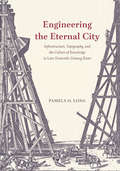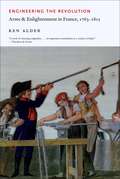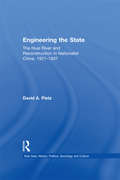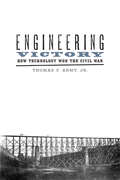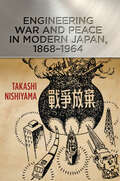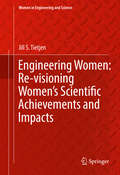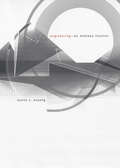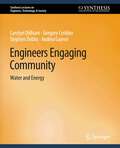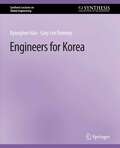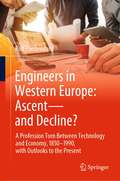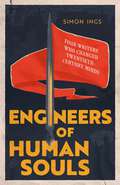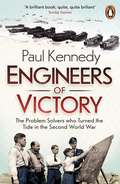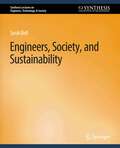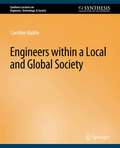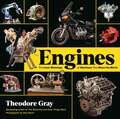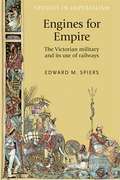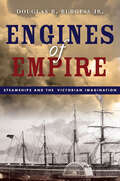- Table View
- List View
Engineering the Eternal City: Infrastructure, Topography, and the Culture of Knowledge in Late Sixteenth-Century Rome
by Pamela O. LongBetween the catastrophic flood of the Tiber River in 1557 and the death of the “engineering pope” Sixtus V in 1590, the city of Rome was transformed by intense activity involving building construction and engineering projects of all kinds. Using hundreds of archival documents and primary sources, Engineering the Eternal City explores the processes and people involved in these infrastructure projects—sewers, bridge repair, flood prevention, aqueduct construction, the building of new, straight streets, and even the relocation of immensely heavy ancient Egyptian obelisks that Roman emperors had carried to the city centuries before. This portrait of an early modern Rome examines the many conflicts, failures, and successes that shaped the city, as decision-makers tried to control not only Rome’s structures and infrastructures but also the people who lived there. Taking up visual images of the city created during the same period—most importantly in maps and urban representations, this book shows how in a time before the development of modern professionalism and modern bureaucracies, there was far more wide-ranging conversation among people of various backgrounds on issues of engineering and infrastructure than there is in our own times. Physicians, civic leaders, jurists, cardinals, popes, and clerics engaged with painters, sculptors, architects, printers, and other practitioners as they discussed, argued, and completed the projects that remade Rome.
Engineering the Eternal City: Infrastructure, Topography, and the Culture of Knowledge in Late Sixteenth-Century Rome
by Pamela O. LongBetween the catastrophic flood of the Tiber River in 1557 and the death of the “engineering pope” Sixtus V in 1590, the city of Rome was transformed by intense activity involving building construction and engineering projects of all kinds. Using hundreds of archival documents and primary sources, Engineering the Eternal City explores the processes and people involved in these infrastructure projects—sewers, bridge repair, flood prevention, aqueduct construction, the building of new, straight streets, and even the relocation of immensely heavy ancient Egyptian obelisks that Roman emperors had carried to the city centuries before. This portrait of an early modern Rome examines the many conflicts, failures, and successes that shaped the city, as decision-makers tried to control not only Rome’s structures and infrastructures but also the people who lived there. Taking up visual images of the city created during the same period—most importantly in maps and urban representations, this book shows how in a time before the development of modern professionalism and modern bureaucracies, there was far more wide-ranging conversation among people of various backgrounds on issues of engineering and infrastructure than there is in our own times. Physicians, civic leaders, jurists, cardinals, popes, and clerics engaged with painters, sculptors, architects, printers, and other practitioners as they discussed, argued, and completed the projects that remade Rome.
Engineering the Revolution: Arms and Enlightenment in France, 1763-1815 (Princeton Legacy Library)
by Ken AlderEngineering the Revolution documents the forging of a new relationship between technology and politics in Revolutionary France, and the inauguration of a distinctively modern form of the “technological life.” Here, Ken Alder rewrites the history of the eighteenth century as the total history of one particular artifact—the gun—by offering a novel and historical account of how material artifacts emerge as the outcome of political struggle. By expanding the “political” to include conflict over material objects, this volume rethinks the nature of engineering rationality, the origins of mass production, the rise of meritocracy, and our interpretation of the Enlightenment and the French Revolution.
Engineering the Revolution: Arms and Enlightenment in France, 1763-1815 (Princeton Legacy Library)
by Ken AlderEngineering the Revolution documents the forging of a new relationship between technology and politics in Revolutionary France, and the inauguration of a distinctively modern form of the “technological life.” Here, Ken Alder rewrites the history of the eighteenth century as the total history of one particular artifact—the gun—by offering a novel and historical account of how material artifacts emerge as the outcome of political struggle. By expanding the “political” to include conflict over material objects, this volume rethinks the nature of engineering rationality, the origins of mass production, the rise of meritocracy, and our interpretation of the Enlightenment and the French Revolution.
Engineering the Revolution: Arms and Enlightenment in France, 1763-1815
by Ken AlderEngineering the Revolution documents the forging of a new relationship between technology and politics in Revolutionary France, and the inauguration of a distinctively modern form of the “technological life.” Here, Ken Alder rewrites the history of the eighteenth century as the total history of one particular artifact—the gun—by offering a novel and historical account of how material artifacts emerge as the outcome of political struggle. By expanding the “political” to include conflict over material objects, this volume rethinks the nature of engineering rationality, the origins of mass production, the rise of meritocracy, and our interpretation of the Enlightenment and the French Revolution.
Engineering the Revolution: Arms and Enlightenment in France, 1763-1815
by Ken AlderEngineering the Revolution documents the forging of a new relationship between technology and politics in Revolutionary France, and the inauguration of a distinctively modern form of the “technological life.” Here, Ken Alder rewrites the history of the eighteenth century as the total history of one particular artifact—the gun—by offering a novel and historical account of how material artifacts emerge as the outcome of political struggle. By expanding the “political” to include conflict over material objects, this volume rethinks the nature of engineering rationality, the origins of mass production, the rise of meritocracy, and our interpretation of the Enlightenment and the French Revolution.
Engineering the State: The Huai River and Reconstruction in Nationalist China, 1927–37 (East Asia: History, Politics, Sociology and Culture)
by David PietzUsing case studies of large-scale public works projects in the Huai River valley of central China, this title illustrates the manner in which the Nationalist governmentst sought to re-establish central administrative control which fractured following the fall of the empire.
Engineering the State: The Huai River and Reconstruction in Nationalist China, 1927–37 (East Asia: History, Politics, Sociology and Culture)
by David PietzUsing case studies of large-scale public works projects in the Huai River valley of central China, this title illustrates the manner in which the Nationalist governmentst sought to re-establish central administrative control which fractured following the fall of the empire.
Engineering Victory: How Technology Won the Civil War (Johns Hopkins Studies in the History of Technology)
by Thomas F. Army Jr.Engineering Victory brings a fresh approach to the question of why the North prevailed in the Civil War. Historian Thomas F. Army, Jr., identifies strength in engineering;¢;‚¬;€?not superior military strategy or industrial advantage;¢;‚¬;€?as the critical determining factor in the war;€™s outcome.Army finds that Union soldiers were able to apply scientific ingenuity and innovation to complex problems in a way that Confederate soldiers simply could not match. Skilled Free State engineers who were trained during the antebellum period benefited from basic educational reforms, the spread of informal educational practices, and a culture that encouraged learning and innovation. During the war, their rapid construction and repair of roads, railways, and bridges allowed Northern troops to pass quickly through the forbidding terrain of the South as retreating and maneuvering Confederates struggled to cut supply lines and stop the Yankees from pressing any advantage.By presenting detailed case studies from both theaters of the war, Army clearly demonstrates how the soldiers;€™ education, training, and talents spelled the difference between success and failure, victory and defeat. He also reveals massive logistical operations as critical in determining the war;€™s outcome.
Engineering Victory: How Technology Won the Civil War (Johns Hopkins Studies in the History of Technology)
by Thomas F. Army Jr.Engineering Victory brings a fresh approach to the question of why the North prevailed in the Civil War. Historian Thomas F. Army, Jr., identifies strength in engineering;¢;‚¬;€?not superior military strategy or industrial advantage;¢;‚¬;€?as the critical determining factor in the war;€™s outcome.Army finds that Union soldiers were able to apply scientific ingenuity and innovation to complex problems in a way that Confederate soldiers simply could not match. Skilled Free State engineers who were trained during the antebellum period benefited from basic educational reforms, the spread of informal educational practices, and a culture that encouraged learning and innovation. During the war, their rapid construction and repair of roads, railways, and bridges allowed Northern troops to pass quickly through the forbidding terrain of the South as retreating and maneuvering Confederates struggled to cut supply lines and stop the Yankees from pressing any advantage.By presenting detailed case studies from both theaters of the war, Army clearly demonstrates how the soldiers;€™ education, training, and talents spelled the difference between success and failure, victory and defeat. He also reveals massive logistical operations as critical in determining the war;€™s outcome.
Engineering War and Peace in Modern Japan, 1868–1964 (Johns Hopkins Studies in the History of Technology)
by Takashi NishiyamaNaval, aeronautic, and mechanical engineers played a powerful part in the military buildup of Japan in the early and mid-twentieth century. They belonged to a militaristic regime and embraced the importance of their role in it. Takashi Nishiyama examines the impact of war and peace on technological transformation during the twentieth century. He is the first to study the paradoxical and transformative power of Japan’s defeat in World War II through the lens of engineering.Nishiyama asks: How did authorities select and prepare young men to be engineers? How did Japan develop curricula adequate to the task (and from whom did the country borrow)? Under what conditions? What did the engineers think of the planes they built to support Kamikaze suicide missions? But his study ultimately concerns the remarkable transition these trained engineers made after total defeat in 1945. How could the engineers of war machines so quickly turn to peaceful construction projects such as designing the equipment necessary to manufacture consumer products? Most important, they developed new high-speed rail services, including the Shinkansen Bullet Train. What does this change tell us not only about Japan at war and then in peacetime but also about the malleability of engineering cultures?Nishiyama aims to counterbalance prevalent Eurocentric/Americentric views in the history of technology. Engineering War and Peace in Modern Japan, 1868–1964 sets the historical experience of one country’s technological transformation in a larger international framework by studying sources in six different languages: Chinese, English, French, German, Japanese, and Spanish. The result is a fascinating read for those interested in technology, East Asia, and international studies. Nishiyama's work offers lessons to policymakers interested in how a country can recover successfully after defeat.
Engineering War and Peace in Modern Japan, 1868–1964 (Johns Hopkins Studies in the History of Technology)
by Takashi NishiyamaNaval, aeronautic, and mechanical engineers played a powerful part in the military buildup of Japan in the early and mid-twentieth century. They belonged to a militaristic regime and embraced the importance of their role in it. Takashi Nishiyama examines the impact of war and peace on technological transformation during the twentieth century. He is the first to study the paradoxical and transformative power of Japan’s defeat in World War II through the lens of engineering.Nishiyama asks: How did authorities select and prepare young men to be engineers? How did Japan develop curricula adequate to the task (and from whom did the country borrow)? Under what conditions? What did the engineers think of the planes they built to support Kamikaze suicide missions? But his study ultimately concerns the remarkable transition these trained engineers made after total defeat in 1945. How could the engineers of war machines so quickly turn to peaceful construction projects such as designing the equipment necessary to manufacture consumer products? Most important, they developed new high-speed rail services, including the Shinkansen Bullet Train. What does this change tell us not only about Japan at war and then in peacetime but also about the malleability of engineering cultures?Nishiyama aims to counterbalance prevalent Eurocentric/Americentric views in the history of technology. Engineering War and Peace in Modern Japan, 1868–1964 sets the historical experience of one country’s technological transformation in a larger international framework by studying sources in six different languages: Chinese, English, French, German, Japanese, and Spanish. The result is a fascinating read for those interested in technology, East Asia, and international studies. Nishiyama's work offers lessons to policymakers interested in how a country can recover successfully after defeat.
Engineering Women: Re-visioning Women's Scientific Achievements And Impacts (Women in Engineering and Science)
by Jill S. TietjenPacked with fascinating biographical sketches of female engineers, this chronological history of engineering brightens previously shadowy corners of our increasingly engineered world’s recent past. In addition to a detailed description of the diverse arenas encompassed by the word ‘engineering’ and a nuanced overview of the development of the field, the book includes numerous statistics and thought provoking facts about women’s roles in the achievement of thrilling scientific innovations. This text is a unique resource for students launching research projects in engineering and related fields, professionals interested in gaining a broader understanding of how engineering as a discipline has been impacted by events of global significance, and scholars of women’s immense, often obscured, contributions to scientific progress.
Engineering—An Endless Frontier
by Sunny Y. AUYANGGenetic engineering, nanotechnology, astrophysics, particle physics: We live in an engineered world, one where the distinctions between science and engineering, technology and research, are fast disappearing. This book shows how, at the dawn of the twenty-first century, the goals of natural scientists--to discover what was not known--and that of engineers--to create what did not exist--are undergoing an unprecedented convergence. Sunny Y. Auyang ranges widely in demonstrating that engineering today is not only a collaborator with science but its equal. In concise accounts of the emergence of industrial laboratories and chemical and electrical engineering, and in whirlwind histories of the machine tools and automobile industries and the rise of nuclear energy and information technology, her book presents a broad picture of modern engineering: its history, structure, technological achievements, and social responsibilities; its relation to natural science, business administration, and public policies. Auyang uses case studies such as the development of the F-117A Nighthawk and Boeing 777 aircraft, as well as the experiences of engineer-scientists such as Oliver Heaviside, engineer-entrepreneurs such as Henry Ford and Bill Gates, and engineer-managers such as Alfred Sloan and Jack Welch to give readers a clear sense of engineering's essential role in the future of scientific research. Table of Contents: Preface 1. Introduction 2 . Technology Takes Off 2.1 From Practical Art to Technology 2.2 Construction Becomes Mathematical 2.3 Experimenting with Machines 2.4 Science and Chemical Industries 2.5 Power and Communication 3. Engineering for Information 3.1 From Microelectronics to Nanotechnology 3.2 Computer Hardware and Software 3.3 Wireless, Satellites, and the Internet 4. Engineering in Society 4.1 Social Ascent and Images of Engineers 4.2 Partnership in Research and Development 4.3 Contributions to Sectors of the Economy 5. Innovation by Design 5.1 Inventive Thinking in Negative Feedback 5.2 Design Processes in Systems Engineering 5.3 “Working Together� in Aircraft Development 5.4 From Onboard Computers to Door Hinges 6. Sciences of Useful Systems 6.1 Mathematics in Engineering and Science 6.2 Information and Control Theories 6.3 Wind Tunnels and Internet Simulation 6.4 Integrative Materials Engineering 6.5 Biological Engineering Frontiers 7. Leaders Who Are Engineers 7.1 Business Leaders in the Car Industry 7.2 Public Policies and Nuclear Power 7.3 Managing Technological Risks Appendix A. Statistical Profiles of Engineers Appendix B. U.S. Research and Development Notes Index I am impressed by the scope of Engineering - An Endless Frontier, and fascinated by Sunny Auyang's comprehensive knowledge of the subject. This is just the kind of book the National Academy of Engineering has been encouraging to promote the importance of engineering to the public. It will have a long shelf-life in that it pulls together material that is not readily accessible, and will serve as a reference for anyone interested in engineering as a profession. Engineering needs this book!--John Hutchinson, Harvard UniversityEngineering - An Endless Frontier is extraordinary in scope. Sunny Auyang describes the different kinds of contemporary engineering practices and productions, attempts to provide historical background, explains the scientific basis for engineering innovation in different fields, and addresses the broad, systems level managerial, entrepreneurial, and design activities of professionals. It's rare to find a single author who can grasp and explain the essential features of modern technologies across such an array of industrial sectors and engineering disciplines and explain how they work, why they work they way they do,
Engineers Engaging Community: Water and Energy (Synthesis Lectures on Engineers, Technology, & Society)
by Carolyn Oldham Gregory Crebbin Stephen Dobbs Andrea GaynorWater and energy are fundamental elements of community well-being and economic development, and a key focus of engineering efforts the world over. As such, they offer outstanding opportunities for the development of socially just engineering practices. This work examines the engineering of water and energy systems with a focus on issues of social justice and sustainability. A key theme running through the work is engaging community on water and energy engineering projects: How is this achieved in diverse contexts? And, what can we learn from past failures and successes in water and energy engineering? The book includes a detailed case study of issues involved in the provision of water and energy, among other needs, in a developing and newly independent nation, East Timor.
Engineers for Korea (Synthesis Lectures on Global Engineering)
by Kyonghee Han Gary Lee DowneyThis book follows the fraught attempts of engineers to identify with Korea as a whole. It is for engineers, both Korean and non-Korean, who seek to become better critical analysts of their own expertise, identities, and commitments. It is for non-engineers who encounter or are affected by Korean engineers and engineering, and want to understand and engage them. It is for researchers who serve as critical participants in the making of engineers and puzzle over the contents and effects of techno-national formation.
Engineers in Western Europe: A Profession Torn Between Technology and Economy, 1850–1990, with Outlooks to the Present
by Rolf TorstendahlIn his book, pending between history and sociology, on engineers in thirteen countries of the western part of Europe, Professor Rolf Torstendahl approaches the development from around 1850 up to the present situation from different angles. - One examines the educational patterns and the author shows how widely different types of formation of engineers existed in Britain, France and Germany in the early period. They were paradigmatic for other countries. Differences remain but patterns have gradually become similar. - From another angle the author makes professional organisations of engineers a main object of study, and they vary from alumni associations to powerful lobby organisations. - A third approach in the book is to examine engineers versus sociological theories of professionalism on the one hand and theories of managerialism on the other. In the last chapter the author also discusses topics like technocracy and the responsibility of engineers.
Engineers of Human Souls: Four Writers Who Changed Twentieth-Century Minds
by Simon IngsFour writers. Four dictators. One world, changed out of all recognition. ENGINEERS OF HUMAN SOULS is an intimate and shocking shadow history of creative vanity in a time that turned writers - once the faithful servants of authority - into figures of political consequence.Maurice Barrès, who first wielded the politics of identity. Gabriele D'Annunzio, whose poetry became a blueprint for fascism. Maxim Gorky, dramatist of the working class and Stalin's cheerleader. The Maoist Ding Ling, whose stories exculpated the regime that kept her imprisoned.All four nursed extravagant visions of the future, and believed they were vital to its realisation. Each was lured to the centre of political action. Each established a dangerous and damaging relationship with a notorious dictator. And when writers and rulers find a use for each other, the consequences can be shattering for us all. These stories - of courage and compromise, vanity and malevolence - speak urgently to the uncontrollable power of words.
Engineers of Victory: The Problem Solvers who Turned the Tide in the Second World War
by Paul KennedyFrom Paul Kennedy, author of The Rise and Fall of the Great Powers, one of the most acclaimed history books of recent decades, Engineers of Victory is a new account of how the tide was turned against the Nazis by the Allies in the Second World War. In January 1943 Churchill and Roosevelt and the Combined Chiefs of Staff met in Casablanca to review the western Allies' war aims and strategy. They realised that to attain their ultimate aim of 'unconditional surrender' they would have to achieve some formidable objectives - win control of the Atlantic sea-lanes and command of the air over the whole of West-Central Europe, work out how to land on an enemy-held shore so that Continental Europe could be retaken, how to blunt the Nazi blitzkrieg that a successful invasion would undoubtedly provoke, and finally how to 'hop' across the islands of the Pacific to assault the Japanese mainland. Eighteen months later on, as Paul Kennedy writes, 'these operational aims were either accomplished or close to being so.' The history of the Second World War is often told as a grand narrative. The focus of this book, by contrast, is on the problem-solvers - Major-General Perry Hobart, who invented the 'funny tanks' which flattened the curve on the D-Day beaches; Flight Lieutenant Ronnie Harker 'the man who put the Merlin in the Mustang'; Captain 'Johnny' Walker, the convoy captain who worked out how to sink U-boats with a 'creeping barrage'. The result is a fresh perspective on the greatest, conflict in human history.Paul Kennedy is one of the world's best-selling and most influential historians. He is the author or editor of nineteen books, including The Rise and Fall of the Great Powers, which has been translated into over twenty languages, Preparing for the Twenty-First Century, The Parliament of Man and the now classic Rise and Fall of British Naval Mastery.
Engineers, Society, and Sustainability (Synthesis Lectures on Engineers, Technology, & Society)
by Sarah BellSustainable development is one of the key challenges of the twenty-first century. The engineering profession is central to achieving sustainable development. To date, engineering contributions to sustainability have focused on reducing the environmental impacts of development and improving the efficiency of resource use. This approach is consistent with dominant policy responses to environmental problems, which have been characterised as ecological modernisation. Ecological modernisation assumes that sustainability can be addressed by reforming modern society and developing environmental technologies. Environmental philosophers have questioned these assumptions and call into question the very nature of modern society as underlying the destruction of nature and the persistence of social inequality. Central to the crises of ecology and human development are patterns of domination and the separation of nature and culture. Engineering has a clear role to play in ecological modernisation, but its role in more radical visions of sustainability is uncertain. Actor-network theory provides an analysis of socio-technical systems which does not require the separation of nature and culture, and it provides a way of thinking about how engineers are involved in shaping society and its relationship to the environment. It describes the world in terms of relationships between human and non-human actors. It shows that social relationships are mediated by technologies and non-human nature, and that assumptions about society and behaviour are ""baked-in"" to technological systems. Modern infrastructure systems are particularly important in shaping society and have significant environmental impacts. Modern infrastructure has allowed the consumption of resources far beyond basic human needs in developed countries. Failure to deliver infrastructure services has resulted in billions of the world's poorest people missing out on the benefits of modern development. Engineers have an important role to play in developing new infrastructure systems which acknowledge the relationships between technology and society in shaping demand for resources and environmental impacts, as well as alleviating poverty. Engineers have an important role in mediating between the values of society, clients, the environment and the possibilities of technology. Constructive Technology Assessment and Value Sensitive Design are two methodologies which engineers are using to better account for the social and ethical implications of their work. Understanding engineering as a hybrid, socio-technical profession can help develop new ways of working that acknowledge the importance of technology and infrastructure in shaping social relationships that are central to achieving sustainability. Table of Contents: The Origins of Sustainability / Ecological Modernisation / Environmental Ethics / Society and Technology / Engineering Consumption / Sustainable Urban Water Systems / Engineering, Technology and Ethics / Conclusion
Engineers within a Local and Global Society (Synthesis Lectures on Engineers, Technology, & Society)
by Caroline BaillieEngineers, Technology and Society presents topics intended to aid the practicing engineer in reflecting upon the nature and purpose of their own practice within the engineering profession and how that is related to and implicated in social, economic and political issues. The series will include external relations between engineering, economic systems and social and political practices, as well as power structures and working conditions within the organisation. In an increasingly competitive and hostile environment in which practicing engineers are forced to spend their lives fighting for higher profit margins, many engineers become despondent and often leave the profession just a few years after graduation. They do not feel they are engineering for those in need in the world but for a small minority who can pay. There are an increasing number of engineers in the workplace who feel dissatisfied with these issues but do not know where to begin to address them. It is hoped that these books will start a conversation in many parts of the world where diverse engineers are working. This introductory book of the series presents an overview of the key issues at stake. I consider how, as engineers, we might decide what is the right thing to do by exploring rights and notions of freedom and what these might mean in a world where we are, according to some, ‘training for compliance’. I consider engineering in the past and how it has been used to contribute to social contexts in the Western world as well as in developing countries. I look at our responsibility as engineers to learn from the past to enhance our understanding and take appropriate action related to contemporary industrial development and globalization. Finally, I present a case study of my own engineering for others to critique. Practicing what you preach is never easy and living as a just engineer presents many challenges. As Ursula Franklin states clearly in her Massey lectures which I discuss in chapter 1, engineers have choices; it is up to us to ensure that we are aware of the way in which our engineering practice contributes to global social, economic and political issues so that we are able to make response – able choices.
Engines: The Inner Workings of Machines That Move the World
by Theodore GrayThe international bestselling author of How Things Work and The Elements Trilogy turns his focus to a visual exploration of the inner workings and functionality of the marvelous machines that run our world—from the first steam engines to giant turbines to today's tiny electrical engines. In Engines, the always entertaining and informative Theodore Gray explores the glorious guts and intricate innards of dozens of impressive machines. Through his engaging and unexpected stories and Nick Mann&’s trademark gorgeous photography, Gray takes us on a journey from ancient Greek steam engines to our most sophisticated twenty-first-century machinery. We take time to appreciate the detailed functionality of the internal combustion engine, the connection between magnetism and electric motors, as well as hydraulics, robotics, and more. Each chapter builds on the previous, illuminating the evolution of engines and revealing the ingenuity brought to bear as humans invented and perfected these marvelous mechanical systems. Along the way, Gray regales us with tales of his own experiences working with and collecting these machines. For fans of how things are made and how they work, Engines is a loving tribute to the mechanical world.
Engines: The Inner Workings of Machines That Move the World
by Theodore GrayThe international bestselling author of How Things Work and The Elements Trilogy turns his focus to a visual exploration of the inner workings and functionality of the marvelous machines that run our world—from the first steam engines to giant turbines to today's tiny electrical engines. In Engines, the always entertaining and informative Theodore Gray explores the glorious guts and intricate innards of dozens of impressive machines. Through his engaging and unexpected stories and Nick Mann&’s trademark gorgeous photography, Gray takes us on a journey from ancient Greek steam engines to our most sophisticated twenty-first-century machinery. We take time to appreciate the detailed functionality of the internal combustion engine, the connection between magnetism and electric motors, as well as hydraulics, robotics, and more. Each chapter builds on the previous, illuminating the evolution of engines and revealing the ingenuity brought to bear as humans invented and perfected these marvelous mechanical systems. Along the way, Gray regales us with tales of his own experiences working with and collecting these machines. For fans of how things are made and how they work, Engines is a loving tribute to the mechanical world.
Engines for empire: The Victorian army and its use of railways (Studies in Imperialism)
by Edward SpiersEngines for Empire examines the use of the railway by the British army from the 1830s to 1914, a period of domestic political strife and unprecedented imperial expansion. The book uses a wide array of sources and images to demonstrate how the Victorian army embraced this new technology, how it monitored foreign wars, and how it came to use the railway in both support and operational roles. The British army's innovation is also revealed, through its design and use of armoured trains, the restructuring of hospital trains, and in its capacity to build and repair railway track, bridges, and signals under field conditions. This volume provides insights on the role of railways in imperial development, as a focus of social interaction between adversaries, and as a means of projecting imperial power. It will make fascinating reading for students, academics and enthusiasts in military and imperial history, Victorian studies, railway history and colonial warfare.
Engines of Empire: Steamships and the Victorian Imagination
by Douglas R. Burgess Jr.In 1859, the S.S. Great Eastern departed from England on her maiden voyage. She was a remarkable wonder of the nineteenth century: an iron city longer than Trafalgar Square, taller than Big Ben's tower, heavier than Westminster Cathedral. Her paddles were the size of Ferris wheels; her decks could hold four thousand passengers bound for America, or ten thousand troops bound for the Raj. Yet she ended her days as a floating carnival before being unceremoniously dismantled in 1889. Steamships like the Great Eastern occupied a singular place in the Victorian mind. Crossing oceans, ferrying tourists and troops alike, they became emblems of nationalism, modernity, and humankind's triumph over the cruel elements. Throughout the nineteenth century, the spectacle of a ship's launch was one of the most recognizable symbols of British social and technological progress. Yet this celebration of the power of the empire masked overconfidence and an almost religious veneration of technology. Equating steam with civilization had catastrophic consequences for subjugated peoples around the world. Engines of Empire tells the story of the complex relationship between Victorians and their wondrous steamships, following famous travelers like Mark Twain, Charles Dickens, and Jules Verne as well as ordinary spectators, tourists, and imperial administrators as they crossed oceans bound for the colonies. Rich with anecdotes and wry humor, it is a fascinating glimpse into a world where an empire felt powerful and anything seemed possible—if there was an engine behind it.
